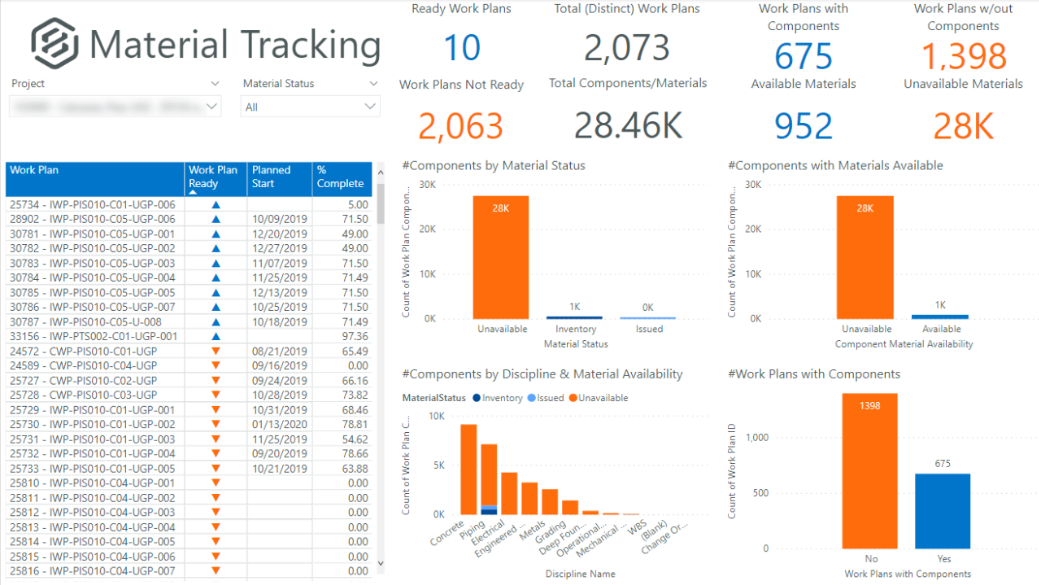Coordinating and sequencing work across the project life cycle through the adoption of Advanced Work Packaging (AWP) can reduce total installed cost by 10%*. A large part of this coordination effort involves ensuring that project teams have the right equipment, materials and instructions to complete their work according to the plan and schedule. AWP drives optimization by aligning planning and field execution to ensure that all constraints against a work package are removed before execution in the field.
Materials represent one of the most critical constraints against a work package, and historically, access to accurate and timely information about material availability for a work package has been difficult to achieve. While there are many reasons for that can explain this lack of access to information, one key reason that has become obvious over the last decade is the underlying work process used to collect, process and analyze information regarding material availability and status.
Obstacles to Information
Traditional, paper-based data collection methods and disconnected, manual data entry work processes used to manage materials are the obvious culprit. In addition, the age-old procurement and materials management systems rely on a few individuals assigned to a project who have been trained and have access to these legacy systems. Not only does this scenario often result in latency and inaccuracy of data-recording of material transactions, but it also results in the dissemination of information about material availability and status via PDF and Excel-based reports.
In many cases, field engineers oversee keeping track of the status of material components for their scope of work via direct correspondence with the vendors that supply the materials. Items are manually received against the paper packing lists and then stored in a warehouse or laydown based on a rudimentary grid system. This paper-based, manual process resulted in duplicate orders/overages, unknown statuses, missed shortages, and unclear material locations.
Digital Solutions
Many companies are now implementing a Digital Supply Chain and Digital Workflows via integrated solutions to provide a single source of truth regarding material availability and status. The real-time material information provided by these digital material workflows (termed Material Readiness®) is crucial to AWP and allows the workface planner or field engineer to plan their work based on real-time information collected through the digital workflows.
Best practice is to start your digital workflow at the source of information — with your suppliers, using barcodes or RFID to create digital packing lists (aka Digital Supply Chain). The Digital Supply Chain is best defined as transforming the traditional exchanges of information from document-centric to data-centric, as it relates to the construction supply chain. In the same way aspects of EPC construction have moved upstream (e.g., modular construction), the Digital Supply Chain program moves digital creation of inbound asset information upstream and enables suppliers to publish asset data at the point of origin.
This approach removes data entry from the project site and transfers ownership back to the supplier or the original source of the information about the material and equipment being supplied. This improves project visibility into the physical structure of materials arriving at the jobsite, providing a better understanding of the supply chain, which translates into a deeper understanding of constructability.
A Digital Supply Chain program promotes digitally assigning all assets to a parent tag and/or work plan (CWP/IWP). Clearly defining supplier bill of materials through the digital supply chain process ensures that all widgets are properly tied to a work package so that when a package is requested, main tags as well as sub-components are issued to construction. This prevents an environment of unmanaged “Ship Loose” which often leads to inefficiencies regarding the proper management of the assets. Additionally, being able to understand all components related to CWPs/IWPs prevents improper issuing of assets to construction crews.
This increased visibility into material constraints against a work package can reduce workface disruptions due to “short issue” of materials needed for a work package and has proven to reduce construction crew disruptions significantly. Correctly issuing IWPs keeps crews productive and foremen/superintendents in the field managing work, rather than chasing missing materials from incomplete issuances.
A Key Partnership
With the InEight/Jovix® partnership, projects can define work packages and subsequently identify the bill of material (BOM) associated with specific work packages. This visibility is provided in a dashboard showing work-ready plans and allowing for a drill-down of those work plans with missing components. While it has been a long road for the industry towards digital workflows, the projects utilizing it are relishing constraint-free work packages to stay on budget and keep on schedule. And we can only continue to evolve from here.
*Source: CII




